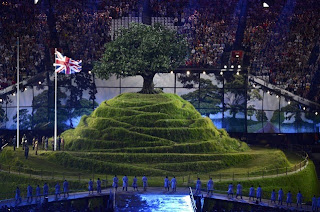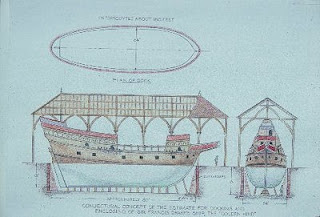A British Institution
We are still riding the crest of British pride and celebration from the summer of 2012. From the London Olympics to the Queens Jubilee the country has been able to reflect on what makes Britain truly great. Danny Boyle’s impressive opening ceremony showcased Britain as a lush ‘green and pleasant land’ with a striking 40ft, 3 Tonne Oak tree standing proudly on a grassy mound in the opening sequence of the ceremony. The BBC also labelled the ancient species as ‘the tree that shaped Britain’ when the paneling in the House of Commons was replaced with solid oak. The iconic foliage was embossed on the 2012 £5 Olympic coin. |
| Oak Tree at London 2012 Olympics |
Beech family ‘Fagaceae’. Some species including the native Sessil and English Oak are able to grow to 40m in height and can reach a circumference of 12m! With very distinctive foliage the tree can produce up to 50,000 acorns intermittently in ‘mast years’ . Only a small proportion of these woodlands are now present across Britain as much of the land has been converted to agriculture.
William the Conqueror famously claimed the Oak woodlands as the hunting grounds of Kings in his ‘Forest Law’. Landowners were no longer able to hunt freely on their own land as William preserved his ‘New Forest’ game for his favourite past time as he had done in Normandy! Anyone caught stealing any deer or boar would be sentenced to mutilation! Later, in the 17th century, the Forest Law was amended in the Magna Carta giving land-owners more rights before, finally, the law was abolished towards the end of the century.
By the time the Forest Law was abolished, a large proportion of the British forests had been uprooted; the monetisation of the forest had truly started to take place. Oak wood is perfect for construction with a density of around 0.75 g/cm3, great strength, hardness, insect and fungal resistant (due to its high Tannin Content and appealing grain markings . For years Oak trees supplied Britain with timber for a variety of different trades and crafts. Famously the fleets that included Sir Francis Drake’s Golden Hind and Nelson’s Victory used the wood of up to 2,500 oak trees to set sail on their adventurous missions to open new trade links with new nations . Therefore the British Oak not only provided fuel for people across that land it also helped us forge trade links which we are still utilising today! As Nelson’s sailors sang, ‘Hearts of oak are our ships; jolly tar’s are our men!’
 |
| Golden Hind in Dry Dock |
Whilst the tree had been heralded as a native and national treasure it didn’t stop resources falling to the floor in the early winter of 1703. Britain was hit by a hurricane force storm which resulted in 4000 Oak’s falling in the New Forest alone. The Oak had been seen as a key driver of Britain’s fortunes and this was a real blow for the country who admired the material to excess. During the 18th century the replanting efforts were in full swing driven by the need for naval timber as landowners were encouraged to do the patriotic (and profitable!) thing and replant oak on their holdings - ‘The very idea of Britain - a new idea - was planted with the acorns’. The BBC explains that at the height of Oak Mania the tree became emblematic of liberty and freedom as it fuelled various war efforts.
Today many of the Oak trees left in the UK are classified as either veteran or ancient trees including the Major Oak in the world-famous, Robin Hood-territory, Sherwood Forest . The Major Oak is estimated to weigh approximately 23 tons and has a girth of approximately 33’’ . Whilst we may not rely on Oak for ship building today, it is widely used in home improvements and, as we can attest, it can be used to create stunning wood floors. The Oak Tree is a national treasure standing for unity, strength and Great Britain.
Images
http://www.indrakeswake.co.uk/Artefacts/goldenhind.htm